The WFSU Ecology Blog has an updated Leon County Lake Report, posted in June of 2021 (Click here).
Rob Diaz de Villegas WFSU-TV
Last week on our Water Moves EcoAdventure, we showed images of polluted waterways south of Tallahassee. We in this area benefit from a large amount of protected lands, which surround us with scenic views as well as protect many of our rivers and streams. But Tallahassee itself is fairly urban; our paved roadways move pollutants into drainage ditches and sloughs instead of letting them sink into the ground to be filtered by the aquifer. Some waterways are more affected than others. Our lakes and rivers provide us with fresh fish and recreation; when they become compromised by algal blooms and other pollutants, they affect the health and economy of the communities around the resources.
With that in mind, I’ve compiled this list of lakes in the area, with data for each on cleanliness and safety concerns. We’re looking at three things:
- Nutrient load for each lake. We’ll link to a PDF of a report published by Leon County Public Works, which was compiled by Johnny Richardson (who we interviewed in the Water Moves video). I can’t link to the individual pages, but I will list them with the link back to the document if you’re interested in reading more.
- How safe is it to eat the fish in each lake? For this, I’m using a report created by the Florida Department of Health (DOH). This is also a PDF, and I’ll be referencing it in the same way.
- Toxic algal blooms. DOH has an Algal Bloom tracker which lists three locations in Leon County. During the rainy season, these blooms will get flushed, but the locations listed have had persistent nutrient problems and are still a risk to bloom when the weather dries.
North Leon: The Red Hills
Our largest lakes are located in the north of the county. This is a sparsely populated area, protected to the north by over 300,000 acres of forested land held on hunting plantations. Our recent Red Hills EcoAdventure explored some of these waterways and the land protecting them. These are the cleanest lakes in Leon County.
Lake Iamonia (5,554 acres, the largest lake in Leon County)
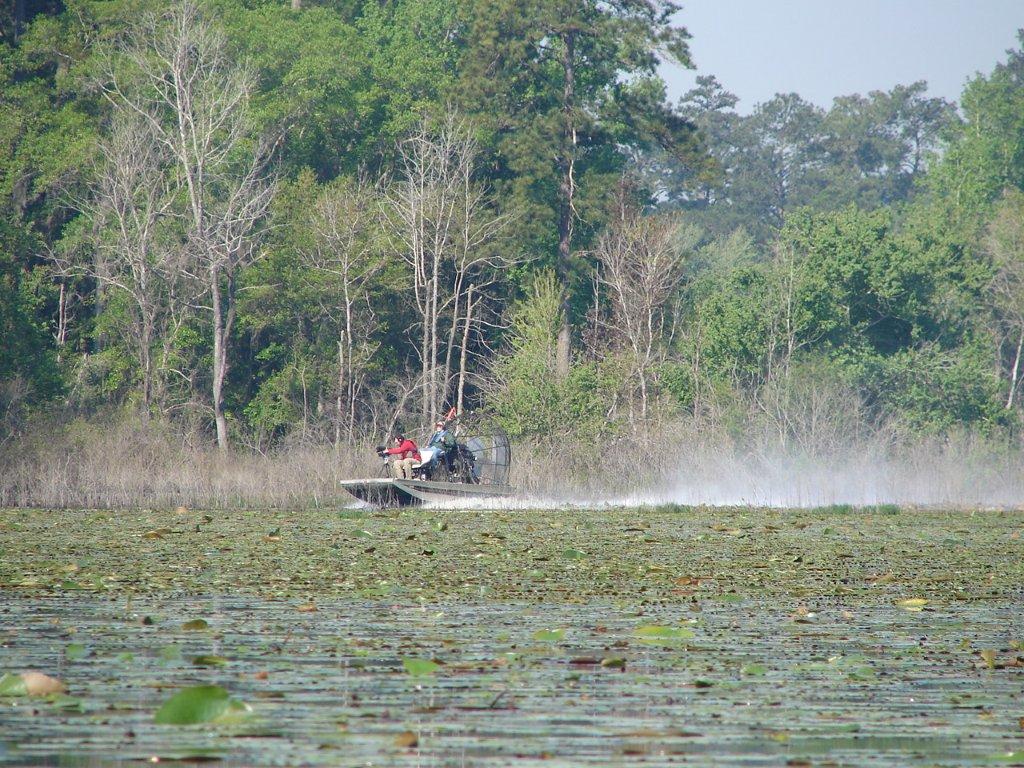
Florida Fish & Wildlife’s Michael Hill takes me out on Lake Iamonia near Tall Timbers Research Station.
Nutrients: The report we cite was issued by Leon County in 2011. The report uses a measurement developed by FDEP, called a Trophic State Index, to determine the health of a waterbody. It’s a formula that weighs nutrient levels (phosphorous, nitrogen, and chlorophyl a), with a score of 60 or higher denoting an impaired waterbody (40 for clearwater lakes, which are lower nutrient systems). Lake Iamonia’s scores over the last few years are well blow that, averaging in the low 40s (chart on Page 64).
Fish Safety: According to the DOH Freshwater Fish Guide, this is a fairly healthy lake. Florida lakes and rivers are considered to have low to medium mercury levels, so the guide puts limits on how much they recommend that an individual eats. They recommend most fish caught in Iamonia be eaten no more than twice a week (page 16) for most species (slightly less for children and pregnant/ trying to get pregnant mothers). This is as high as they go for any Florida waterbody.
Other Concerns: As we learned during the Red Hills Water EcoAdventure, the lake’s sinkhole was impounded in the 1930s. While the dam has been removed, there is ecological damage that could take generations to fix.
Lake Miccosukee (6,257 acres. It forms the northeast border of Leon County, but is located in Jefferson County)
Nutrients: It averages in the 50s on the TSI index (page 174-5); below the impairment level but higher than Iamonia due to an elevation of one particular nutrient, chlorophyl a. This may be related to the dam constructed around its sinkhole in 1954. It’s a story you see on many area lakes, playing out slightly differently on each. Impounded lakes end up with floating islands of vegetation, tussocks, which block the sun and add organic material to the sediment. This vegetation might be responsible for the elevated chlorophyl.
Fish Safety: The high amount of vegetation on the surface has reduced the amount of dissolved oxygen in the water, and so there aren’t a lot of fish in the lake. Of the two species listed on the DOH document, it recommends no more than twice a week (page 18) for bluegill and once a week for largemouth bass. This is typical for bass throughout the document; some fish store more mercury in their fat cells.
Lake Jackson (4,000 acres)
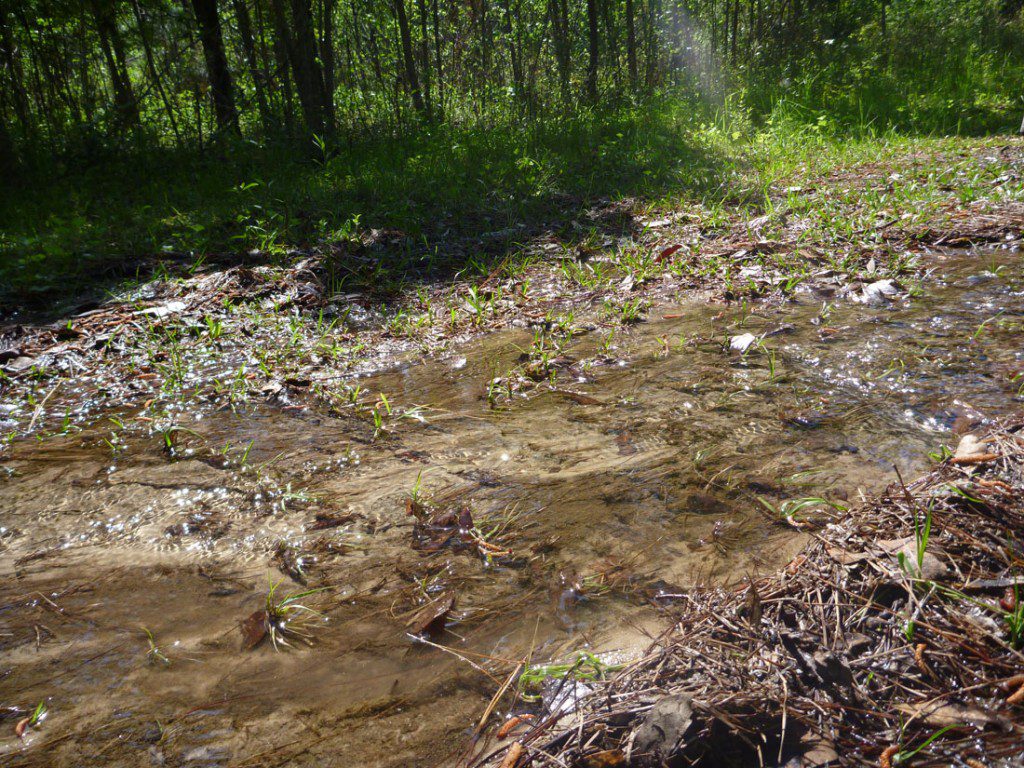
Stormwater runoff in Elinor Klapp-Phipps Park. This plot of land is adjacent to Lake Jackson, which is why it was purchased by the Northwest Florida Water Management District. Having protected land next to the lake reduces urban runoff into it.
Nutrients: Over the course of the last few years, the color of the lake’s surface has clarified, so it technically qualifies as a clearwater lake with a lower TSI threshold. As such, it would be considered an impaired lake, averaging in the 40s on the TSI index (page 95). The report questions using the lower threshold, citing “the dynamic nature of the lake and the recent drought” (pages 95-96). Part of the change in color is attributed to changes in stormwater management, which have reduced runoff to the lake.
Fish Safety: Bluegill & redear sunfish, twice a week. Largemouth bass, once a week (page 16).
Lake Hall (182 acres, a part of the Lake Jackson Watershed)
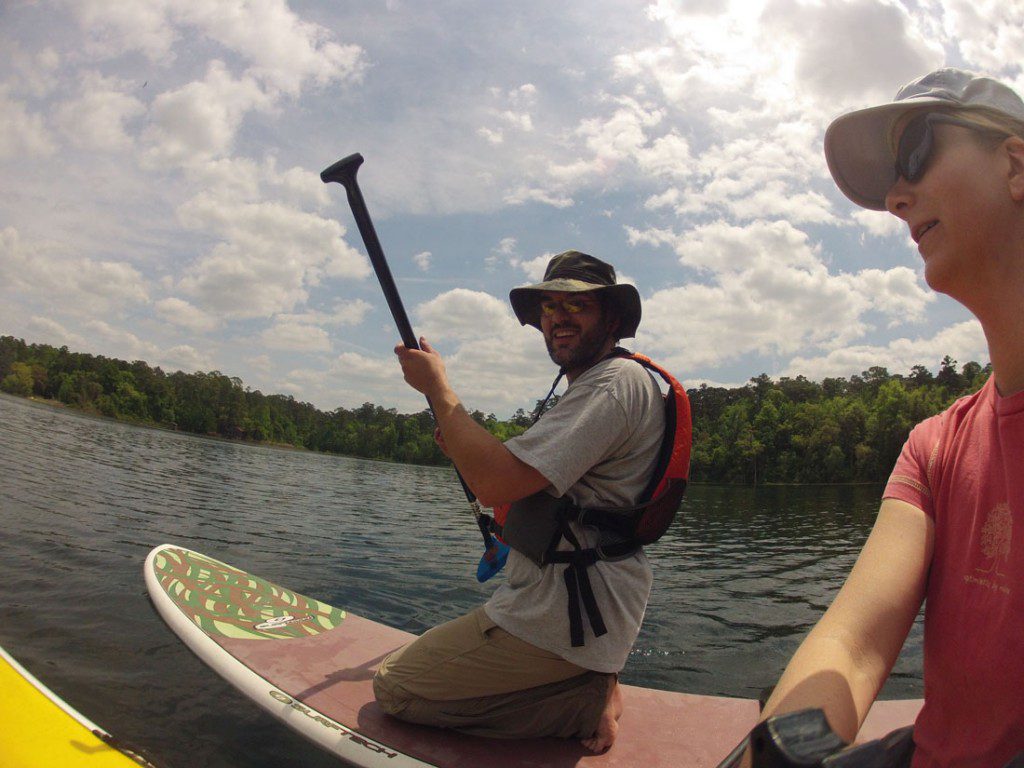
Tall Timbers’ Georgia Ackerman teaches me to stand up paddleboard on Lake Hall, as part of our Red Hills Water EcoAdventure.
Nutrients: Lake Hall is one of the cleanest lakes in Leon County, averaging in the high 20s (page 91) on the TSI. As a clearwater lake, it’s threshold for impairment is 40. Lake Hall is partially located in Alfred B. Maclay Gardens State Park. There are some restrictions on the use of motors on Lake Hall.
Fish Safety: Not listed. The lake is fished pretty regularly, however.
Middle Leon County
Lake Lafayette
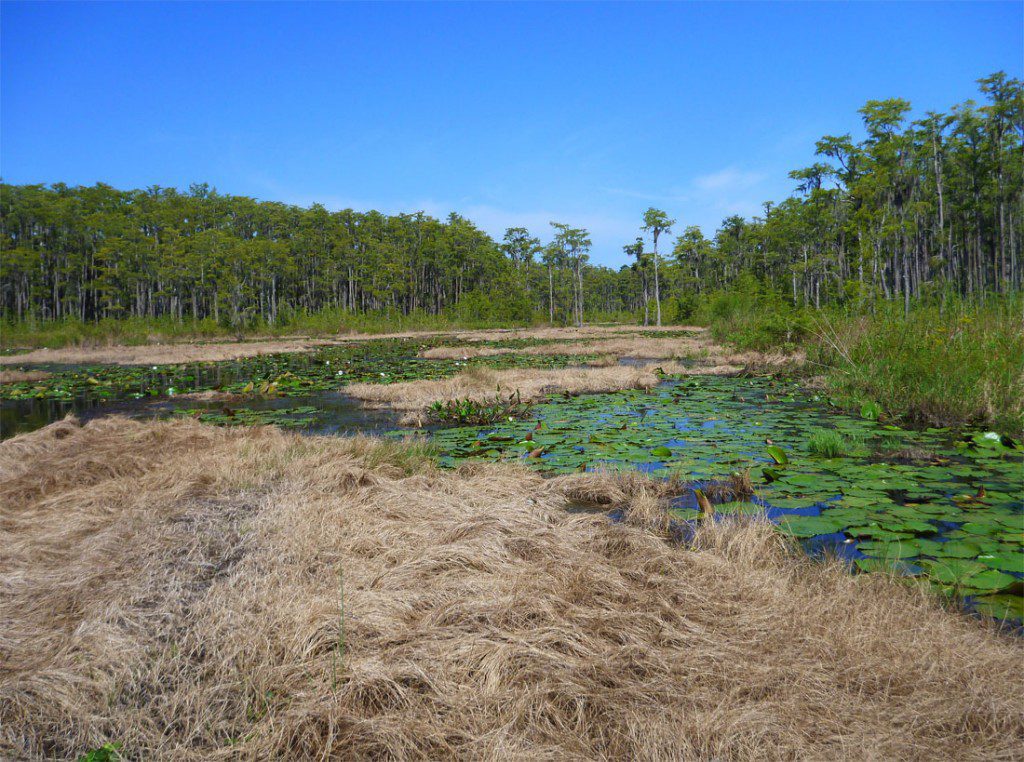
Dead vegetation on the surface of Lower Lake Lafayette. The segmentation of the lake in the early twentieth century has affected its ability to “dry down.” Many Leon county lakes naturally empty into sinkholes every few years, and the plants and animals that live in the lakes have adapted to and thrive in such conditions. Impounding Lake Lafayette has caused floating mats of vegetation to form on its surface, disrupting the lake’s ecology. Clearing the vegetation is an involved and expensive process.
As we learned on our Lafayette Heritage Trail Park EcoAdventure last year, the historical Lake Lafayette has been segmented into four smaller lakes by earthen dams. As with other lakes in our area (Iamonia, Jackson, and Miccosukee), its sinkhole was separated to prevent the lake from draining. The sinkhole is in Upper Lake Lafayette. The other lakes are Piney Z. Lake, the Alford Arm, and Lower Lake Lafayette (which feeds the St. Marks River). Impounding the lake has resulted in tussocks and accumulation of mucky sediment, as in the other lakes.
This lake is north of the Cody Escarpment and is considered a part of the Red Hills. I classify it differently because of its more urban setting.
Nutrients :
- Upper Lake Lafayette: Based on its color, its TSI index is 40. It regularly exceeds that threshold, averaging about 50 TSI (page 132) and going into the 90s in 2005. This part of the lake drains housing developments and is adjacent to the Walmart/ Costco shopping center on Mahan Drive.
- Piney Z. Lake: Like Upper Lafayette, Piney Z.’s threshold is 40 TSI. The lake regularly exceeds that, with scores typically between 50-70 TSI (page 136), and sometimes higher. In late 2013, WFSU-FM reporter Lynn hatter reported on a toxic algal bloom on Piney Z. The Department of Health’s Algal Bloom Tracking Tool still has a mark on the lake, though I don’t know how often that data gets updated. The lake is bordered by Piney Z. Plantation housing development, whose newsletter advised residents on methods to reduce their nutrient contribution to the lake.
- Alford Arm: Alford Arm drains the Miccosukee Greenway, the J.R. Alford Greenway, and the Welaunee Plantations. It’s threshold is 60 TSI, and its average TSI is in the low 40s (page 140).
- Lower Lake Lafayette: Its threshold is 60 TSI, and it has only exceeded that once in the last ten years, in 2004. While its score came perilously close to 60 for a couple of years after that, since 2006 its TSI score has dropped into the low 40s/ upper 30s (page 146).
Fish Safety: Only Piney Z. is listed, recommending no more than two a week (page 27) for all species. I’m not sure if this data was collected before or after the toxic algal bloom.
Lake Talquin (6,963. It is a larger lake than Iamonia, but it is an artificial lake created by a hydroelectric dam on the Ochlockonee River)
Nutrients: The lake averages in the low 50s on the TSI index, below its threshold of 60 (page 253).
Fish Safety: Two a week for all species except largemouth bass (page 22).
Lake Talquin is recognized as an outstanding body of water by the Florida Department of Environmental Protection.
The Bradford Chain of Lakes
The Bradford chain is comprised of three connected lakes: Bradford, Hiawatha, and Cascade.
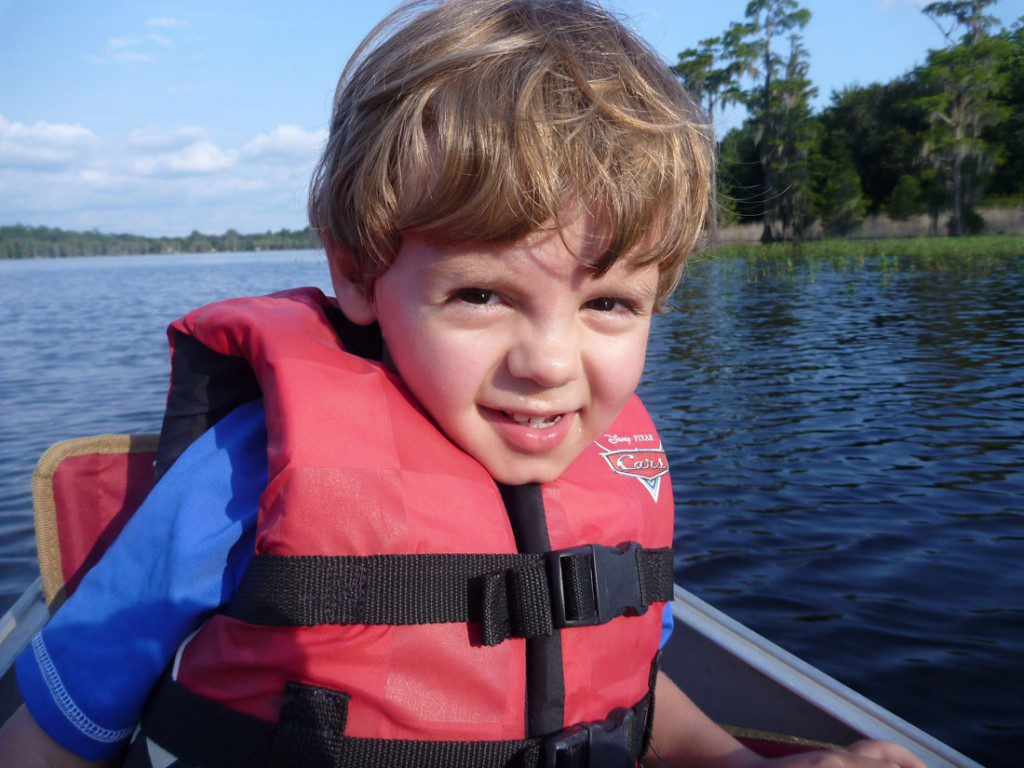
The first time I ever paddled a canoe or kayak was in my mid-twenties, at the FSU Seminole Reservation on Lake Bradford. Wanting to get my son Max out on the water at a younger age, I took him there last year.
Nutrients:
- Lake Bradford: It averages in the 40s on the TSI index (page 191), which is below its threshold of 60. It has risen since 2006; prior to then it had averaged in the 30s (the report theorizes that this may be due to runoff created by Tropical Storm Faye in late 2008). Lake Bradford sits between the FSU Seminole Reservation and the Tallahassee Museum, and drains the residential area between Orange Avenue and Capital Circle.
- Lake Hiawatha: The lake averages in the 40s on the TSI index (page 194), below its threshold of 60. While paddling the corridor between Lake Bradford and Lake Hiawatha, you pass the Florida panther enclosure in the Tallahassee Museum.
- Lake Cascade: Lake Cascade Averages in the low 30s on the TSI index (page 197), well below its threshold of 60. This lake is susceptible to drought. The report lists gaps where water could not be collected due to low levels.
Fish Safety: Not listed.
South Leon
Lake Munson (255 acres)
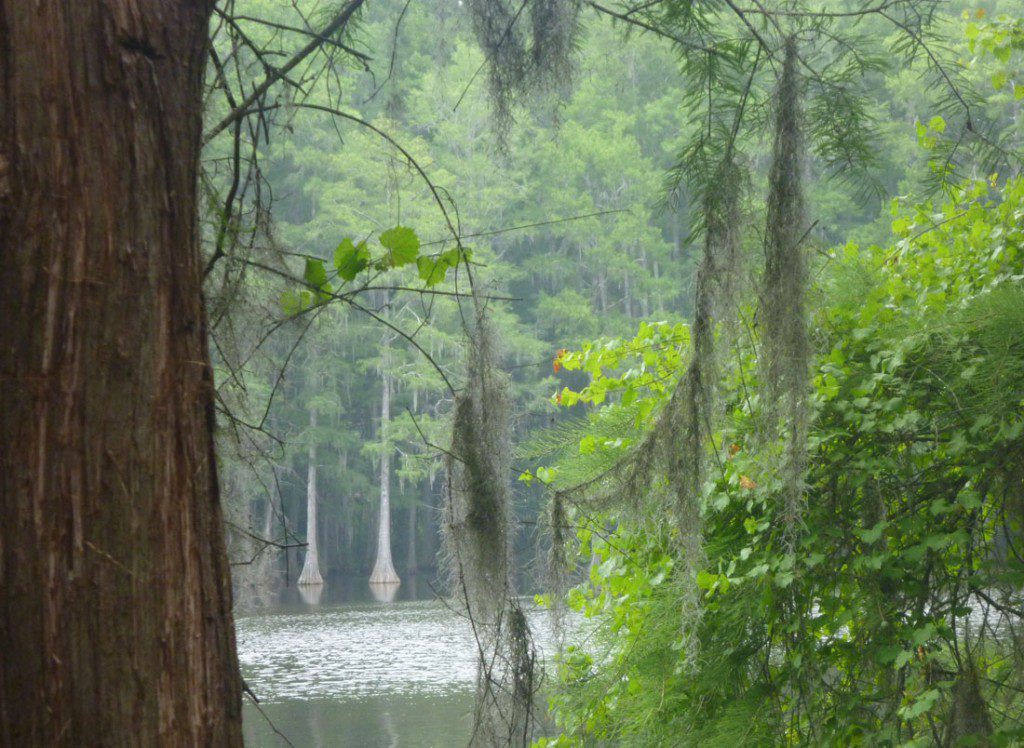
The sad thing about Lake Munson is that it is really an attractive lake. It is believed to have once been a cypress swamp, that had its water impounded in the 1800s. It is still ringed by cypress trees.
Nutrients: “The lake has a history of severe water quality and ecologic problems including fish kills, algal blooms, floating aquatic vegetation, high nutrient and bacterial levels, low game fish productivity, sediment contamination, and depressed oxygen levels (Maristany and Bartel, 1989)” (page 206). Lake Munson routinely exceeds 60 on the TSI index (page 208), though it will dip below the threshold seasonally, sometimes for over a year. When I visited the lake earlier in the month, Johnny Richardson told me that the heavy rain we’ve gotten does help to flush the lake. The DOH Algal Bloom tracking tool reports toxic blooms on both Lake Munson and on Munson Slough to the north of the lake (the slough also continues to the south through the Apalachicola National Forest, partially draining into Wakulla Springs). The tool merely reports that there have been blooms recently. The blooms had washed away when I visited, but Mr. Richardson expects them back in the summer.
Fish Safety: The DOH guide recommends no more than twice a week for all species but black crappie (page 19). This is their recommendation based on mercury level. There is a warning for PCBs (Polychlorinated biphenyl, an endocrine disruptor, page 35). It recommends, based on PCB concerns in largemouth bass, no more than one meal a month. That’s if you’re willing to put any amount of it in your body to begin with.
Additional Concerns: At several points over the last ten years, Lake Munson has exceeded the acceptable levels of fecal coliform (page 216). Fecal coliform is caused by human or animal waste, and an excess could be due to septic tank failures or sewage overflows.
So that’s the good, the bad, and the ugly of our local lakes. There is plenty of good recreation and fishing to be had, but it is helpful to know which bodies of water present potential health risks. Most of the problems are preventable, if people are willing to make changes. Some of the changes aren’t too much of a burden, and others have benefits beyond reducing personal pollution. We’ll look at some of those in the coming weeks.
